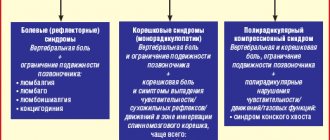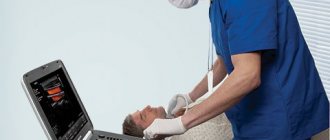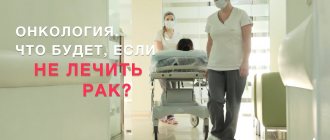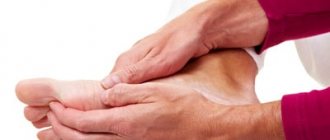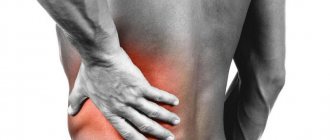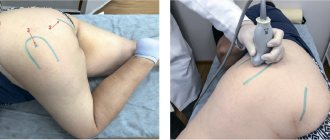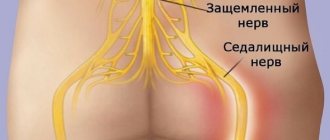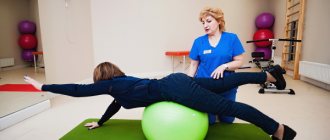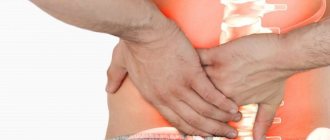Lumbago, what is it? Symptoms and treatment regimen
Lumbago (lumbago) is a sudden, paroxysmal pain in the waist region that lasts from 5-10 minutes to 5-6 hours.
Symptoms intensify during the patient's movements, sneezing, walking, coughing, physical activity, and spread to the posterior surfaces of the legs and buttocks. Such patients are always in a forced position due to tension in the back muscles and the inability to fully straighten. The duration of the pain varies, it can be 5-15 minutes or 2-3 hours, sometimes it lasts for several days.
More often it appears due to osteochondrosis of the spine and intervertebral hernias. Lumbago is common among men aged 28-38 years. Often this pathology is difficult to distinguish from radiculitis. In some cases, lumbar sciatica occurs - a combination of lumbago and sciatica. At the same time, the nature of the pain is aggravated, penetrating deep into the muscles, bones, ligaments in the form of lumbago, pulsation, and puncture.
What it is?
Lumbago is a collective concept that combines a group of pathological conditions characterized by dystrophic and degenerative processes in the spine.
One of the most common types of dorsopathies is spinal osteochondrosis, accompanied by deterioration of the properties of intervertebral discs in the form of a decrease in their elasticity and height. This process takes a long time and is not accompanied by lumbago. In extreme cases, lumbodynia occurs - aching pain in the lower back. But lumbago is a consequence of a typical complication of osteochondrosis - disc herniation.
What causes lower back pain (causes)
Factors that provoke pain in the lower back:
- physical overload;
- sharp turns of the body;
- hypothermia;
- injuries;
- pregnancy;
- and even psycho-emotional stress.
In addition, physical inactivity (lack of stress on the muscles), poor nutrition, and excess weight have a negative impact on the condition of the spine.
The most common cause of lumbago is pathology of the spine, intervertebral joints, discs, as well as the connective and muscle tissues surrounding the spine.
The lower back bears the maximum load, associated primarily with upright posture. That is why this part of the spinal column is most susceptible to the development of dystrophic, degenerative and inflammatory changes that cause compression of nerve fibers, accompanied by a sensation of pain.
Causes
Effective treatment of lumbago is impossible without establishing the main diagnosis. Relieving acute pain is only a first aid measure for the patient. If the pathology that caused the symptoms of lumbago is not eliminated, future relapses are inevitable.
Among the main causes of lumbago are:
- Curvature of the spine (scoliosis, pathological lordosis).
- Injuries. Excessive physical effort may cause ligament tears, bulging or displacement of discs.
- Osteochondrosis. As a result of the long course of the disease, the vertebrae become displaced relative to each other, osteophytes (bone outgrowths) appear, and deformation and damage to the ligaments and intervertebral discs develop.
- Anomalies of the structure of the spine. Up to 30% of the total population is at risk. Among the congenital pathologies there are: additional and missing vertebrae in the lumbar and sacral regions, irregular shape, location and connection of the vertebrae and their parts, splitting of the arches.
- Spondylitis. The tissues of the vertebral bodies are damaged as a result of an inflammatory process of an infectious nature.
- Tumors. The spine, like other organs, can be affected by a tumor. Benign bone tumors (osteomas, osteoblastomas), vascular hemangiomas, malignant osteosarcomas, and metastatic foci have a destructive effect on the vertebrae.
- Spondyloarthritis. Inflammation caused by non-infectious pathologies - ankylosing spondylitis, psoriasis and other rheumatological diseases.
Symptoms of lumbago
Symptoms of lumbago (popularly “lumbago”) occur for the following reasons:
- Infringement of the nerve fiber in the thickness of the muscle due to hypothermia and heavy lifting;
- Changes in the mobility of intervertebral segments. Nerve trunks pass through the intervertebral discs, which can be pinched due to hernial protrusion, osteochondrosis, spondylosis;
- When a person lies on his stomach for a long time while sleeping with his legs pulled up.
Symptoms of lumbago appear most often after hypothermia or heavy lifting. At the slightest turn, bend, or movement, a person experiences pain that prevents him from straightening the lumbar spine.
Clinical signs are formed depending on the cause of the disease:
- With spastic muscle contractions - diffuse pain in the back;
- In osteochondrosis – local pain syndrome of the spine;
- With intervertebral hernia – pain radiating to the buttocks and lower extremities;
- With hyperlordosis - periodic aching pain for 1-2 days.
General practitioners and neurologists know that the diagnosis of lumbago can be made when a person complains of a lumbago after standing under running water. The patient feels discomfort after leaving the bathroom, and a forced posture occurs after a few minutes - this is how lumbago begins.
The disease lasts 1-2 days (with osteochondrosis) or several months (with intervertebral hernia).
Diagnostics
When a patient has lower back pain, a clinical examination alone is not enough to make a diagnosis. The use of additional research methods is required, the results of which will reliably confirm the doctor’s assumption. Considering the variety of causes of lumbago, the following procedures may have diagnostic value:
- X-ray of the spine.
- Tomography (computer or magnetic resonance imaging).
- Densitometry (determination of bone mineral density).
- Biochemical blood test (rheumatic tests, inflammation indicators, calcium, immunogram, tumor markers).
The examination should include examination by specialized specialists: a vertebrologist, traumatologist, rheumatologist or oncologist. The results obtained allow us to make a final conclusion about the cause of lumbago in the patient.
How to treat lumbago?
Complex therapy includes various methods of treating lumbago - medication, physiotherapy and alternative. Treatment is carried out in stages. At the first stage, pain symptoms are relieved at home, then complex therapy begins to eliminate the causative factor.
In the acute period, the patient is usually prescribed:
- Antispasmodics. Such as Baralgin, Papaverine. These drugs help reduce painful muscle spasms.
- Analgesics are non-hormonal anti-inflammatory drugs with pronounced analgesic effectiveness. For example, Diclofenac, Ketonal, Ibuprofen, Dexalgin. Many of these drugs are produced in topical forms, allowing for combination treatment.
- Diuretics to reduce tissue swelling in the lumbar region. Furosemide is most often prescribed. To prevent the development of potassium deficiency, which is washed out of the body under the influence of diuretic drugs, patients are prescribed Panangin at the same time.
- A special bandage for fixing the affected area of the spine.
At the end of the acute period, patients are prescribed physiotherapy, massage, reflexology and exercise therapy. These therapeutic measures help to permanently eliminate muscle spasms and restore normal mobility to the lower back.
If during the examination of the patient some pathology of the spine was revealed, after eliminating the pain syndrome it is necessary to treat it. In the case of intervertebral hernias and displacement of the vertebrae, even surgical intervention may be required.
Treatment
Photo: kruiz.etnomir-otel.ru
Painkillers are prescribed to relieve pain. As a rule, nonsteroidal anti-inflammatory drugs (NSAIDs) with pronounced analgesic activity are used. As you know, pain during an attack of lumbago is unbearable and cannot always be relieved by taking NSAIDs. That is why, in some cases, non-opioid analgesics of central action are used. If the pain syndrome persists, they resort to narcotic analgesics, which have a maximum analgesic effect. To eliminate hypertonicity of the paravertebral muscles, muscle relaxants are used - drugs that relax the muscles.
The following physiotherapeutic treatment methods are used:
- Diadynamic therapy is a physiotherapeutic method of treatment based on exposure to electric current with a frequency of 50 – 100 Hz;
- amplipulse therapy is a method of electrotherapy based on the effect of sinusoidal modulated currents on the human body for therapeutic purposes;
- laser therapy is a physiotherapeutic method of treatment that involves the use of light energy from laser radiation;
- electrophoresis is a physiotherapeutic procedure that involves introducing a medicinal product into the body tissues through intact skin, carried out using a direct electric (galvanic) current;
- Magnetic therapy is a method of physiotherapeutic treatment based on the use of a static magnetic field.
Physiotherapeutic methods of treatment reduce the severity of pain, eliminate tissue swelling, trigger regenerative processes, and improve lymph and blood circulation at the site of exposure.
After the acute period of the disease has subsided, physical therapy classes are prescribed. Special gymnastic exercises have a complex effect on the cartilaginous structures of the spinal column and surrounding soft tissues. Exercise therapy has the following effects:
- strengthens the muscular frame of the spinal column, thereby preventing the development of intervertebral hernias;
- activates metabolic processes in the joints of the spine;
- increases the elasticity of cartilage and ligaments of the spinal column;
- increases range of motion;
- reduces the risk of relapse of the disease.
Massage also has a good effect, which can reduce pain and also eliminate muscle hypertonicity. During the massage, metabolic processes are activated, blood circulation improves and lymph outflow is normalized. In addition, it has been proven that after a high-quality session, emotional tension and stress are reduced. This is achieved by increasing the level of endorphins during the massage. It is important to note that massage is prescribed only after the acute period of the disease has stopped, since it can adversely affect the existing inflammatory process and increase tissue swelling.
Currently, manual therapy is becoming popular. All manipulations of this therapy are carried out by a specially trained doctor, since technically incorrect execution of techniques can cause harm to a person. The goal of manual therapy is to restore the correct anatomical position of the vertebrae and intervertebral discs. Due to this, pain is eliminated and vertebral mobility is restored. However, it should be noted that this method of treatment does not eliminate the cause of the disease, but only helps to reduce the severity of the clinical picture.
Another representative of alternative medicine is acupuncture. This treatment method is based on the impact of thin needles on certain biologically active points located on the human body. An acupuncture session varies in duration, but usually does not exceed 1 hour. The sensations during acupuncture vary: some patients report mild discomfort, but in most cases the procedure is painless.
Diet
During the treatment of lumbago, the patient needs to follow a diet. The diet is based on the following products:
- lean beef or chicken;
- low-fat fish;
- low-fat dairy products;
- various cereals;
- vegetables and fresh herbs;
- fruits, berries, natural juices.
You should completely avoid fatty and irritating foods: smoked meats, pickles, marinades, spices and herbs, fatty meat or lard. Flour and sweet foods can be consumed in moderation. Avoid alcohol completely.
Massage and therapeutic exercises
A light massage during the development of an attack of lumbago improves local blood circulation, normalizes lymph flow, eliminates pain, swelling and inflammation. In this case, it is permissible to use only soft techniques in the lumbar region. These include rubbing, stroking, kneading. It is better to avoid serious effects during the period of exacerbation.
During an attack of lumbago, any physical activity is contraindicated. However, this does not mean that you need to lie motionless. Therapeutic exercises may include exercises such as rotating the feet, curling the toes, and raising and lowering the arms and legs. You can also do breathing exercises.
From the 3-4th day of illness, the list of permissible movements can be expanded. Exercises for lumbago may include the following:
- raising the pelvis from a lying position;
- spreading bent knees to the sides;
- pulling the feet towards the buttocks;
- head lifts with abdominal tension;
- rounding and relaxing the back.
After a week, you can perform slow leg swings while standing on your hands and knees. It is also allowed to raise the shoulder girdle while lying on your back with your legs bent. Thanks to the systematic implementation of useful exercises, it is possible to activate blood circulation, normalize lower back mobility, and stretch muscle tissue and the spine.
Medicines
Photo: spektrnews.in.ua
Nonsteroidal anti-inflammatory drugs (NSAIDs) inhibit the enzyme COX (cyclooxygenase), resulting in the disruption of the synthesis of prostaglandins from arachidonic acid. Thanks to this, the following effects are achieved: antipyretic, anti-inflammatory, analgesic. To relieve an attack of lumbago, NSAIDs are used, which have a pronounced analgesic effect. These drugs include: analgin, diclofenac, ketorolac.
The most well-known representative of non-opioid analgesics of central action is flupirtine (catadolone). It is an activator of neuronal potassium channels. In addition to the analgesic effect, it has a muscle relaxant effect, which plays an additional role in the treatment of the disease. While taking the drug, the following side effects may develop: general weakness, dizziness, nausea, occasionally vomiting, stool upset (constipation or diarrhea), flatulence (bloating), sleep disturbance, sweating, headache. The drug is contraindicated in the presence of hypersensitivity to the active or auxiliary substances, liver failure, cholestasis, myasthenia gravis, and is also not recommended for use in children under 18 years of age, pregnant and lactating women.
Narcotic analgesics are used for severe pain that is not relieved by non-narcotic drugs. In most cases, tramadol or promedol is used. Narcotic analgesics suppress the perception of pain at all stages of pain signal transmission. This is achieved by interacting with opiate receptors and mimicking the effects of endogenous opiates. Their strong analgesic activity allows them to be used in various fields of medicine, however, it is important to note that long-term use of these drugs threatens the development of mental and physical dependence.
Muscle relaxants are medications that relax muscles. The drugs are prescribed both in tablet and injectable form. However, it is worth noting that when taken orally, the drugs are poorly absorbed in the gastrointestinal tract, resulting in a weak muscle relaxant effect. That is why preference is given to the parenteral route of administration, due to which the drug is well distributed in all tissues of the body, resulting in the desired effect.
The following representatives of this group of drugs are most often prescribed:
- tolperisone (mydocalm). This drug is available both in tablets and in the form of injections. The effect is achieved within 24 hours immediately after the first dose. However, do not forget that to reinforce the effect, it is necessary to extend the intake to at least 10 days.
- tizanidine (sirdalud). The drug has not only a muscle relaxant, but also an analgesic effect. In addition, it has a mild sedative effect, so it is often prescribed in the evening.
Lumbago with sciatica, what is it and how to treat it?
Lumbago is an intense, sharp pain in the lower back that suddenly occurs when bending over, lifting heavy objects, coughing, or sneezing. Lumbago leads to a sharp limitation of movements.
The patient cannot straighten up, and sometimes even deep breathing causes severe pain. If the pain is localized in a small area on the lower back, then it is lumbago. If the unpleasant sensations spread to the buttock, thigh, lower leg and toes, then this is lumbago with sciatica.
Symptoms of lumbago with sciatica:
- Acute pain in the lower back;
- Burning or tingling along the sciatic nerve;
- Difficulty moving the entire leg or foot;
- Numbness in the buttock and leg;
- Change in gait;
- Constant aching pain in the buttock, back of the thigh, popliteal fossa, lower leg, foot;
- Severe shooting pain when standing up and changing position.
The pain intensifies when sitting and subsides somewhat when walking or lying down. Almost always only one leg is affected.
Treatment of lumbago with sciatica is aimed at relieving inflammation in the nerve roots. Non-steroidal anti-inflammatory drugs, muscle relaxants and B vitamins described in the main part of the article are used.
Lumbar pain (etiology, clinical picture, diagnosis and treatment)
The most common causes of lumbar pain are diseases of the spine, primarily degenerative-dystrophic (osteochondrosis, spondylosis deformans), and overstrain of the back muscles. In addition, various diseases of the abdominal and pelvic organs, including tumors, can cause the same symptoms as a herniated disc that compresses the spinal root. It is no coincidence that such patients turn not only to neurologists, but also to gynecologists, orthopedists, urologists, and above all, of course, to local or family doctors. Etiology and pathogenesis of lumbar pain According to modern concepts, the most common causes of lumbar pain are: – pathological changes in the spine, primarily degenerative-dystrophic; – pathological changes in muscles, most often myofascial syndrome; – pathological changes in the abdominal organs; – diseases of the nervous system. Risk factors for lumbar pain are: – heavy physical activity; – uncomfortable working posture; – injury; – cooling, drafts; – alcohol abuse; – depression and stress; – occupational diseases associated with exposure to high temperatures (in particular, in hot shops), radiation energy, sudden temperature fluctuations, and vibration. Among the vertebral causes of lumbar pain, the following are distinguished: – ischemia of the root (discogenic radicular syndrome, discogenic radiculopathy), resulting from compression of the root by a herniated disc; – reflex muscle syndromes, the cause of which may be degenerative changes in the spine. Various functional disorders of the lumbar spine can play a certain role in the occurrence of back pain, when, due to incorrect posture, blocks of the intervertebral joints occur and their mobility is impaired. In the joints located above and below the block, compensatory hypermobility develops, leading to muscle spasm. Signs of acute compression of the spinal canal are numbness of the perineal area, weakness and numbness of the legs; – delay of urination and defecation; – with compression of the spinal cord, a decrease in pain is observed, followed by a feeling of numbness in the pelvic girdle and limbs. Lumbar pain in childhood and adolescence is most often caused by abnormalities in the development of the spine. Spinal bifida (spina bifida) occurs in 20% of adults. Upon examination, hyperpigmentation, birthmarks, multiple scars and hyperkeratosis of the skin in the lumbar region are revealed. Sometimes urinary incontinence, trophic disorders, and weakness in the legs are noted. Lumbar pain can be caused by lumbarization - the transition of the S1 vertebra in relation to the lumbar spine - and sacralization - the attachment of the L5 vertebra to the sacrum. These anomalies are formed due to individual characteristics of the development of the transverse processes of the vertebrae. Nosological forms Ankylosing spondylitis This disease was first described in 1882 by the outstanding Russian neurologist V.M. Bekhterev called “stiffness of the spine with curvature.” Currently, it is referred to as rheumatoid spondylitis, or ankylosing spondylitis. Almost all patients complain of lower back pain. Ankylosing spondylitis is manifested primarily by inflammation of low-moving joints (intervertebral, costovertebral, lumbosacral joints) and spinal ligaments. Gradually, ossification develops in them, the spine loses elasticity and functional mobility, becomes like a bamboo stick, fragile, and is easily injured. At the stage of pronounced clinical manifestations of the disease, the mobility of the chest during breathing and, as a result, the vital capacity of the lungs significantly decrease, which contributes to the development of a number of pulmonary diseases. Tumors of the spine There are benign and malignant tumors, primarily originating from the spine and metastatic. Benign tumors of the spine (osteochondroma, chondroma, hemangioma) are sometimes clinically asymptomatic. With hemangioma, a spinal fracture can occur even with minor external influences (pathological fracture). Malignant tumors, mostly metastatic, originate from the prostate, uterus, breast, lungs, adrenal glands and other organs. Pain in this case occurs much more often than with benign tumors - usually persistent, painful, intensifying with the slightest movement, depriving patients of rest and sleep. Characterized by a progressive deterioration of the condition, an increase in general exhaustion, and pronounced changes in the blood. X-ray, computed tomography, and magnetic resonance imaging are of great importance for diagnosis. Osteoporosis The main cause of the disease is a decrease in the function of the endocrine glands due to an independent disease or against the background of general aging of the body. Osteoporosis can develop in patients who take hormones, aminazine, anti-tuberculosis drugs, and tetracycline for a long time. Radicular disorders accompanying back pain arise due to deformation of the intervertebral foramina, and spinal disorders (myelopathy) arise due to compression of the radiculomedullary artery or vertebral fracture, even after minor injuries. Myofascial syndrome Myofascial syndrome is the main cause of back pain. It can occur due to overexertion (during heavy physical activity), overextension and bruises of muscles, unphysiological posture during work, reaction to emotional stress, shortening of one leg and even flat feet. Myofascial syndrome is characterized by the presence of so-called “trigger” zones (trigger points), pressure on which causes pain, often radiating to neighboring areas. In addition to myofascial pain syndrome, the cause of pain can also be inflammatory muscle diseases - myositis. Lumbar pain often occurs due to diseases of internal organs: gastric and duodenal ulcers, pancreatitis, cholecystitis, urolithiasis, etc. They can be pronounced and imitate the picture of lumbago or discogenic lumbosacral radiculitis. However, there are also clear differences, thanks to which it is possible to differentiate referred pain from that arising from diseases of the peripheral nervous system, which is due to the symptoms of the underlying disease. Clinical symptoms of lumbar pain Most often, lumbar pain occurs at the age of 25–44 years. There are acute pains, lasting, as a rule, 2–3 weeks, and sometimes up to 2 months, and chronic pains – over 2 months. Compression radicular syndromes (discogenic radiculopathy) are characterized by a sudden onset, often after heavy lifting, sudden movements, or hypothermia. Symptoms depend on the location of the lesion. The occurrence of the syndrome is based on compression of the root by a herniated disc, which occurs as a result of degenerative processes facilitated by static and dynamic loads, hormonal disorders, and injuries (including microtraumatization of the spine). Most often, the pathological process involves areas of the spinal roots from the dura mater to the intervertebral foramen. In addition to disc herniation, bone growths, scar changes in epidural tissue, and hypertrophied ligamentum flavum may be involved in root trauma. The upper lumbar roots (L1, L2, L3) are rarely affected: they account for no more than 3% of all lumbar radicular syndromes. The L4 root is affected twice as often (6%), causing a characteristic clinical picture: mild pain along the inner-lower and anterior surface of the thigh, the medial surface of the leg, paresthesia (sensation of numbness, burning, crawling) in this area; slight weakness of the quadriceps muscle. Knee reflexes are preserved and sometimes even increased. The L5 root is most often affected (46%). The pain is localized in the lumbar and gluteal regions, along the outer surface of the thigh, the anterior-outer surface of the lower leg down to the foot and III-V fingers. It is often accompanied by a decrease in the sensitivity of the skin of the anterior outer surface of the leg and in the strength in the extensor muscles of the third to fifth fingers. The patient finds it difficult to stand on his heel. With long-term radiculopathy, hypotrophy of the tibialis anterior muscle develops. The S1 root is also often affected (45%). In this case, pain in the lower back radiates along the outer back surface of the thigh, the outer surface of the lower leg and foot. Examination often reveals hypalgesia of the posterior outer surface of the leg, decreased strength of the triceps muscle and toe flexors. It is difficult for such patients to stand on their toes. There is a decrease or loss of the Achilles reflex. Vertebrogenic lumbar reflex syndrome It can be acute or chronic. Acute lumbar pain (LBP) (lumbago, “lumbago”) occurs within minutes or hours, often suddenly due to awkward movements. Piercing, shooting (like an electric shock) pain is localized throughout the lower back, sometimes radiating to the iliac region and buttocks, sharply intensifies when coughing, sneezing, and decreases when lying down, especially if the patient finds a comfortable position. Movement in the lumbar spine is limited, the lumbar muscles are tense, causing Lasegue's symptom, often bilateral. Thus, the patient lies on his back with his legs extended. The doctor simultaneously bends the affected leg at the knee and hip joints. This does not cause pain, because with this position of the leg, the diseased nerve is relaxed. Then the doctor, leaving the leg bent at the hip-femoral joint, begins to straighten it at the knee, thereby causing tension on the sciatic nerve, which causes intense pain. Acute lumbodynia usually lasts 5–6 days, sometimes less. The first attack ends faster than subsequent ones. Repeated attacks of lumbago tend to develop into chronic LBP. Atypical lower back pain There are a number of clinical symptoms that are atypical for back pain caused by degenerative changes in the spine or myofascial syndrome. These signs include: – the appearance of pain in childhood and adolescence; – back injury shortly before the onset of lower back pain; – back pain accompanied by fever or signs of intoxication; – lower back pain not associated with spinal movements; – unusual irradiation of pain: in the perineum, abdomen, rectum, vagina, both legs, girdle pain; – connection of lower back pain with eating, defecation, sexual intercourse, urination; – urinary retention or incontinence associated with pain; – gynecological pathology (amenorrhea, dysmenorrhea, vaginal discharge), which appeared against the background of lower back pain; – increased pain in the lower back in a horizontal position and decreased in a vertical position (Razdolsky’s symptom, characteristic of a tumor process in the spine); – steadily increasing pain over one to two weeks; – development of paresis of the lower extremities against the background of lower back pain and the appearance of pathological reflexes. Examination methods – external examination and palpation of the lumbar region, identification of scoliosis, muscle tension, pain and trigger points; – determination of range of motion in the lumbar spine, areas of muscle wasting; – examination of neurological status; determination of tension symptoms (Lassegue, Wasserman, Neri). [Study of Wasserman's symptom: bending the leg at the knee joint in a patient in a prone position causes pain in the thigh. Study of Neri's symptom: sharp bending of the head to the chest of a patient lying on his back with straight legs causes acute pain in the lower back and along the sciatic nerve.]; – study of the state of sensitivity, reflex sphere, muscle tone, vegetative disorders (swelling, changes in color, temperature and humidity of the skin); – radiography, computer or magnetic resonance imaging of the spine; MRI is especially informative (Fig. 1 and 2). – ultrasound examination of the pelvic organs; – gynecological examination; – if necessary, additional studies are carried out: cerebrospinal fluid, blood and urine, sigmoidoscopy, colonoscopy, gastroscopy, etc. Treatment Acute low back pain or exacerbation of vertebral or myofascial syndromes Undifferentiated treatment. Gentle motor mode. In case of severe pain in the first days, bed rest, and then walking on crutches to unload the spine. The bed should be hard, and a wooden board should be placed under the mattress. For warmth, a woolen shawl, an electric heating pad, and bags of heated sand or salt are recommended. Ointments have a beneficial effect: finalgon, tiger, capsin, diclofenac, etc., as well as mustard plasters and pepper plaster. Ultraviolet irradiation in erythemal doses, leeches (taking into account possible contraindications), and irrigation of the painful area with ethyl chloride are recommended. Electrical procedures have an analgesic effect: transcutaneous electroanalgesia, sinusoidal modulated currents, diadynamic currents, electrophoresis with novocaine, etc. The use of reflexology (acupuncture, laser therapy, cauterization) is effective; novocaine blockades, pressure massage of trigger points. Drug therapy includes analgesics, NSAIDs; tranquilizers and/or antidepressants; drugs that reduce muscle tension (muscle relaxants). In case of arterial hypotension, tizanidine should be prescribed with great caution due to its hypotensive effect. If swelling of the spinal roots is suspected, diuretics are prescribed. The main analgesic drugs are NSAIDs, which are often used uncontrollably by patients when pain intensifies or recurs. It should be noted that long-term use of NSAIDs and analgesics increases the risk of complications of this type of therapy. Currently, there is a large selection of NSAIDs. For patients suffering from pain in the spine, due to availability, effectiveness and lower likelihood of side effects (gastrointestinal bleeding, dyspepsia), the preferred “non-selective” drugs are diclofenac 100–150 mg/day. orally, intramuscularly, rectally, locally, ibuprofen and ketoprofen orally 200 mg and topically, and among the “selective” ones – meloxicam orally 7.5–15 mg/day, nimesulide orally 200 mg/day. When treating with NSAIDs, side effects may occur: nausea, vomiting, loss of appetite, pain in the epigastric region. Possible ulcerogenic effect. In some cases, ulceration and bleeding in the gastrointestinal tract may occur. In addition, headaches, dizziness, drowsiness, and allergic reactions (skin rash, etc.) are noted. Treatment is contraindicated for ulcerative processes in the gastrointestinal tract, pregnancy and breastfeeding. To prevent and reduce dyspeptic symptoms, it is recommended to take NSAIDs during or after meals and drink milk. In addition, taking NSAIDs when pain increases together with other medications that the patient takes to treat concomitant diseases leads, as is observed in the long-term treatment of many chronic diseases, to a decrease in adherence to treatment and, as a result, insufficient effectiveness of the therapy. Therefore, modern methods of conservative treatment include the mandatory use of drugs that have chondroprotective, chondrostimulating effects and have a better therapeutic effect than NSAIDs. These requirements are fully met by the drug Teraflex-Advance, which is an alternative to NSAIDs for mild to moderate pain. One capsule of Theraflex-Advance contains 250 mg of glucosamine sulfate, 200 mg of chondroitin sulfate and 100 mg of ibuprofen. Chondroitin sulfate and glucosamine take part in the biosynthesis of connective tissue, helping to prevent cartilage destruction processes and stimulating tissue regeneration. Ibuprofen has analgesic, anti-inflammatory, and antipyretic effects. The mechanism of action occurs due to the selective blocking of cyclooxygenase (COX types 1 and 2), the main enzyme in the metabolism of arachidonic acid, which leads to a decrease in the synthesis of prostaglandins. The presence of NSAIDs in the composition of the drug Theraflex-Advance helps to increase the range of motion in the joints and reduce morning stiffness of the joints and spine. It should be noted that, according to RJ Tallarida et al., the presence of glucosamine and ibuprofen in Theraflex-Advance provides synergism regarding the analgesic effect of the latter. In addition, the analgesic effect of the glucosamine/ibuprofen combination is provided by a 2.4 times lower dose of ibuprofen. After pain relief, it is rational to switch to taking the drug Teraflex, which contains the active ingredients chondroitin and glucosamine. Teraflex is taken 1 capsule 3 times a day. For the first three weeks and 1 capsule 2 times/day. In the next three weeks. In the vast majority of patients, when taking the teraflex, a positive dynamics in the form of a relief syndrome and a decrease in neurological symptoms have a positive dynamics. The drug is well tolerated by patients, not noted allergic manifestations. The use of teraflex for degenerative -dystrophic diseases of the spine is rational, especially in young patients both in combination with NSAIDs and as monotherapy. In combination with NSAIDs, the analgesic effect occurs 2 times faster, and the need for therapeutic doses of NSAIDs is progressively reduced. In clinical practice, for lesions of the peripheral nervous system, including associated with osteochondrosis of the spine, B vitamins, which have neurotropic effects, are widely used. Traditionally, the method of alternating introduction of vitamins B1, B6 and B12 is used for 1-2 ml. intramuscularly with daily alternation. The course of treatment is 2-4 weeks. The disadvantages of this method include the use of small doses of drugs that reduce the effectiveness of treatment and the need for frequent injections. For discogenic radiculopathy, traction therapy is used: traction (including underwater) in a neurological hospital. With myofascial syndrome after local treatment (novocaine blockade, irrigation by chloride ethyl, analgesic ointments) on the muscles for several minutes apply a hot compress. The chronic lumbar pain of vertebrogenic or myogenic origin with a disc hernia is recommended: - wearing a hard corset of the "Bate of the Salt"; - the exclusion of sudden movements and inclinations, restriction of physical exertion; - physiotherapy exercises in order to create a muscle corset and restore muscle mobility; - massage; - novocaine blockade; - reflexology; - Physiotherapy: ultrasound, laser therapy, warming up; - vitamin therapy intramuscularly (B1, B6, B12), polyvitamins with mineral additives; - With paroxysmal pains, carbamazepine is prescribed. Non-drug treatment methods. Despite the presence of effective means of conservative treatment, the existence of dozens of methods, some patients need surgical treatment. Indications for surgical treatment are divided into relative and absolute. An absolute indication for surgical treatment is the development of a caudal syndrome, the presence of a sequestered hernia of the intervertebral disc, a pronounced royal pain syndrome, not decreasing, despite the treatment. The development of radiculomiloichemia also requires emergency surgery, however, after the first 12–24 hours, the indications for surgery in this kind of cases become relative, first, due to the formation of irreversible changes in the roots, and secondary, because in most cases in most cases in The process of treatment and rehabilitation measures regresses for about 6 months. The same period of regression is observed with delayed operations. Relative indications include the inefficiency of conservative treatment, recurrent Ishias. Conservative therapy for duration should not exceed 3 months. And last at least 6 weeks. It is assumed that the surgical approach in the case of acute radicular syndrome and the inefficiency of conservative treatment is justified during the first 3 months. After the appearance of pain to prevent chronic pathological changes in the spine. The relative indication is cases of extremely pronounced pain syndrome, when a change in the pain component of a neurological deficiency occurs. From physiotherapeutic procedures, electrophoresis with proteolytic enzyme caripazim is currently widely used. It is known that therapeutic physical culture and massage inalienable parts of the complex treatment of patients with damage to the spine. Therapeutic gymnastics pursues the goals of the general strengthening of the body, an increase in working capacity, improve coordination of movements, and increase training. At the same time, special exercises are aimed at restoring certain motor functions.
Literature 1. Grachev Yu.V., Shmyrev V.N. Vertebral lumbar pain: multifactorial origin, symptomatology, principles of treatment // Attending physician. 2008 No. 5. p. 6–10. 2. Kadykov A.S., Chernikova L.A., Shakhparonova N.V. Diseases of the peripheral nervous system. Rehabilitation of neurological patients M.: MEDpress –info, 2008. – p. 223–267. 3. Manvelov L.S., Kadykov A.S. Lumbar pain // Attending physician. 1999. No. 4. p. 28–30. 4. Popelyansky Ya.Yu. Diseases of the peripheral nervous system. M.: Medicine, 1989. 464 p. 5. Strelkova N.I. Physical methods of treatment in neurology. – M.: Medicine, 1991. – 320 p.
Prevention
To prevent the occurrence of acute lower back pain, you must:
- Keep away from drafts.
- Strengthen your back muscles by doing exercises.
- No smoking.
- Go swimming.
- Avoid staying in one position for a long time.
- Give yourself gentle physical activity.
- When carrying loads, distribute the weight between two hands.
- Sleep on a semi-rigid or orthopedic mattress.
- Make sure your diet is balanced.
- If there is a disease, osteochondrosis, treat it in a timely manner.
- Lift weights with a straight spine. If necessary, bend your knees.
When lumbago occurs due to negligence, and there are no serious disorders in the spine, then following the doctor’s instructions and bed rest, the patient will recover within two weeks. You should find out the reasons that led to the disease and carry out a course of treatment to eliminate them.
Recovery period
After the main treatment of lumbago, when acute pain and muscle spasms no longer bother you, you can begin to restore the patient’s ability to work. Exercises and massage for lumbago, physiotherapy will ensure quick rehabilitation and long-term remission. As part of post-therapeutic manipulations, doctors may prescribe mud therapy, wearing a corset, or sanatorium treatment.
All information about lumbago, as well as how to treat acute lumbago in the lower back during pregnancy, can be obtained from specialists. You can make an appointment or conduct an appointment online on our website https://www.dobrobut.com/.
Related services: Physical therapy (physical therapy) Massage
